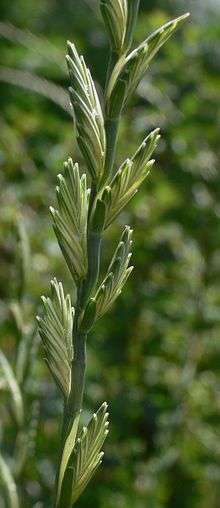Thinopyrum ponticum
| Thinopyrum ponticum | |
|---|---|
 | |
| Scientific classification | |
| Kingdom: | Plantae |
| (unranked): | Angiosperms |
| (unranked): | Monocots |
| (unranked): | Commelinids |
| Order: | Poales |
| Family: | Poaceae |
| Subfamily: | Pooideae |
| Tribe: | Triticeae |
| Genus: | Thinopyrum |
| Species: | T. ponticum |
| Binomial name | |
| Thinopyrum ponticum (Podp.) Z.-W.Liu & R.-C.Wang | |
Thinopyrum ponticum (syn. Agropyron elongatum, Elymus elongatus, Elymus obtusiflorus) is a species of grass known by the common names tall wheatgrass,[1] rush wheatgrass, and Eurasian quackgrass. It is native to Eurasia and it has been introduced to many other parts of the world, including much of the Americas and Australia.[2]
This perennial bunchgrass can grow up to 2 meters tall. The ribbed leaves have pale green blades a few millimeters wide. The inflorescence is a spike studded with spikelets up to 3 centimeters long, each containing up to 12 flowers.[3]
This grass is used as a forage and for hay in many places.[4] It is good for land with saline soils, and it can help reduce the salinity. It is also good for non-saline soils.[5] This grass is commonly crossed with its relative, wheat, in order to give the wheat traits such as stress tolerance and pest resistance.[6][7]
References
- ↑ "Thinopyrum ponticum". Natural Resources Conservation Service PLANTS Database. USDA. Retrieved 9 December 2015.
- ↑ Thinopyrum ponticum. Germplasm Resources Information Network.
- ↑ Thinopyrum ponticum. Grass Manual Treatment.
- ↑ Thinopyrum ponticum. USDA NRCS Plant Guide.
- ↑ Tall wheat grass. Western Australia Department of Agriculture and Food.
- ↑ Oliver, R. E., et al. (2006). Molecular cytogenetic characterization of four partial wheat-Thinopyrum ponticum amphiploids and their reactions to Fusarium head blight, tan spot, and Stagonospora nodorum blotch. Theor Appl Genet 112(8):1473-9.
- ↑ Chen, G., et al. (2012). Molecular cytogenetic identification of a novel dwarf wheat line with introgressed Thinopyrum ponticum chromatin. J Biosci 37(1) 149-55.
External links
| Wikimedia Commons has media related to Thinopyrum ponticum. |